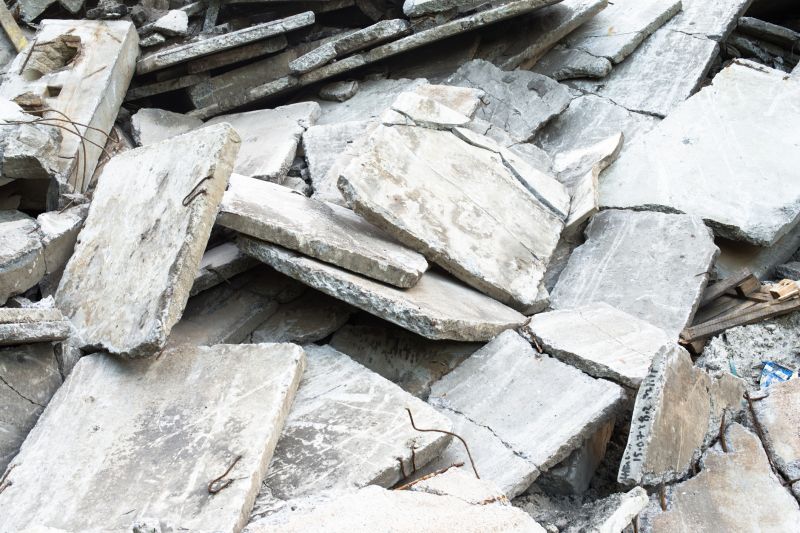Ultimate Guide to Poured Concrete Removal Products and Equipment
Find out which tools and supplies are essential for removing poured concrete effectively and safely in various applications.
 Removing poured concrete can be a challenging task that requires the right tools and products to ensure safety and efficiency. Whether you're undertaking a small repair, renovation, or demolition project, selecting appropriate removal products is essential. These products are designed to break down or detach concrete safely, minimizing damage to surrounding structures and reducing labor effort. Commonly used tools include chemical removers, mechanical demolition equipment, and specialized hand tools, each suited for different scales and types of concrete removal. Proper planning and understanding of the concrete's composition can help determine the most suitable products for your project.
Removing poured concrete can be a challenging task that requires the right tools and products to ensure safety and efficiency. Whether you're undertaking a small repair, renovation, or demolition project, selecting appropriate removal products is essential. These products are designed to break down or detach concrete safely, minimizing damage to surrounding structures and reducing labor effort. Commonly used tools include chemical removers, mechanical demolition equipment, and specialized hand tools, each suited for different scales and types of concrete removal. Proper planning and understanding of the concrete's composition can help determine the most suitable products for your project.
Top Overall Option
Heavy-Duty Concrete Demolition Hammer
A versatile and powerful tool designed for breaking through poured concrete efficiently. Its robust motor and durable chisel attachments make it suitable for various removal tasks, from small patches to large slabs. When selecting a demolition hammer, consider its impact energy, vibration control features, and ergonomic design to ensure comfortable operation over extended periods.
Types of Products For Poured Concrete Removals
Chemical Concrete Removers
Products formulated to soften or dissolve concrete, making it easier to chip away manually or mechanically.
Electric Demolition Hammers
Power tools equipped with rotary or chipping functions for breaking up hardened concrete surfaces.
Pneumatic Jackhammers
Air-powered tools ideal for heavy-duty concrete demolition on larger projects.
Hand Chisels and Pry Bars
Manual tools for small-scale removal or detailed work around edges and embedded fixtures.
Rotary Hammers
Versatile power tools capable of drilling and chipping through concrete with various attachments.
Dust Extraction Systems
Equipment designed to capture dust generated during concrete removal, enhancing safety and cleanliness.
Concrete Saws
Heavy-duty saws fitted with diamond blades for precise cuts and removal of sections of poured concrete.
Hydraulic Breakers
High-force tools suitable for large-scale demolition projects involving thick concrete.
Grinders and Scarifiers
Power tools used to grind or scarify concrete surfaces, often for surface removal or preparation.
Chemical Dissolvers
Specialized chemical agents that weaken concrete bonds for easier removal.
Popular Choices
Widely used for their power and ease of use in breaking up concrete slabs and structures.
Preferred for heavy-duty removal tasks, especially on larger projects requiring high impact force.
Commonly chosen for precise cutting and removal of sections of poured concrete.
Ideal for detailed work and small-scale removal, especially around fixtures or edges.
Popular for maintaining cleaner work environments during removal processes.
Versatile tools favored for their multi-functionality in drilling and chipping concrete.
Often selected for their ability to soften concrete before mechanical removal.
Chosen for their high impact and efficiency on large-scale projects.
Popular for surface preparation and removal of thin layers of concrete.
Chemical removal products often involve active agents that soften or weaken concrete, making it easier to chip away or break apart. Mechanical options include jackhammers, rotary hammers, and demolition hammers, which provide powerful force to break through hardened surfaces. Hand tools such as chisels, pry bars, and sledgehammers are useful for smaller or more precise removal tasks. When choosing products, consider the scope of your project, the thickness of the concrete, and the environment in which you are working. Safety gear like gloves, goggles, and dust masks should always be used to protect against debris and dust.
It's also important to consider the cleanup process after removal. Some products or tools generate a significant amount of dust or debris, requiring appropriate disposal methods or dust suppression techniques. Proper ventilation and protective equipment are critical when working with chemical removers or power tools. Additionally, evaluating the compatibility of removal products with underlying materials can prevent damage to surfaces that need to be preserved or reused. With the right combination of tools and products, concrete removal can be managed more effectively, reducing time and effort while maintaining safety standards.
Key Buying Considerations
- Project scale and scope to determine appropriate tool power and size.
- Type of concrete and its thickness to select suitable removal methods.
- Safety features such as vibration control, ergonomic design, and dust management.
- Compatibility of tools with existing power sources or pneumatic systems.
- Ease of use and operator comfort for prolonged projects.
- Availability of replacement parts and accessories for longevity.
- Environmental conditions, including workspace ventilation and dust control.
- Budget constraints balanced with the durability and effectiveness of the product.
- Specific removal needs, such as precision cuts or large-scale demolition.
- Disposal requirements for debris and dust generated during removal.
- Compatibility with other tools and equipment in your toolkit.
- Level of noise produced and its impact on the work environment.
- Training or skill level required to operate specialized equipment safely.
- Manufacturer reputation and product reviews for reliability.
- Availability of customer support and warranty options.
